Welcome to our comprehensive guide on garden planning tips and ideas. In this article, we will explore various strategies for designing and organizing your garden to maximize its beauty and create a harmonious space with nature.
Key Takeaways:
- Designing and organizing your garden is essential for unlocking nature’s beauty and creating a harmonious space.
- Consider vegetable garden layout and flower bed planning to maximize space and aesthetics.
- Utilize landscaping tips and garden organization techniques to create a well-structured and visually appealing garden.
- Explore different garden layout ideas and utilize planting guides to ensure successful growth and bloom.
- Take advantage of garden planner tools and seek gardening advice to assist in your garden planning journey.
With these garden planning tips and ideas, you can unlock nature’s beauty and create a garden that is both visually stunning and in harmony with the natural world. Whether you’re designing a vegetable garden, planning flower beds, or seeking landscaping tips, this guide will provide you with the knowledge and tools you need to create the garden of your dreams.
Embrace Sustainable Gardening Practices
One of the key aspects of garden planning is embracing sustainable gardening practices. By adopting environmentally conscious strategies, you can create a garden that not only flourishes beautifully but also promotes the well-being of the planet.
Use Human Power
Let’s start by replacing electric or gasoline-powered equipment such as lawnmowers, tillers, and leaf-blowers with more sustainable human-powered alternatives whenever we can. It’ll save natural resources, and by breaking big jobs down into regular smaller blocks, it’s a great way to stay active and keep fit.
Work with Nature
Artificial fertilizers and pesticides are energy intensive to manufacture and carry many undesirable side effects, from polluting rivers to harming beneficial insects and soil life. A natural approach – adding organic materials to the soil to build long-term soil fertility and planting flowers to attract pest predators – avoids these negative impacts while creating a livelier, healthier garden.
Plant Trees
Trees lock up carbon dioxide from the atmosphere, helping to mitigate the effects of our changing climate. Let’s plant more of them! Trees range from tiny to massive to suit every space and can be planted into otherwise wasted or underused parts of the garden. Most are easy to grow, and many trees are productive too – just think of a handsome apple tree, for example.
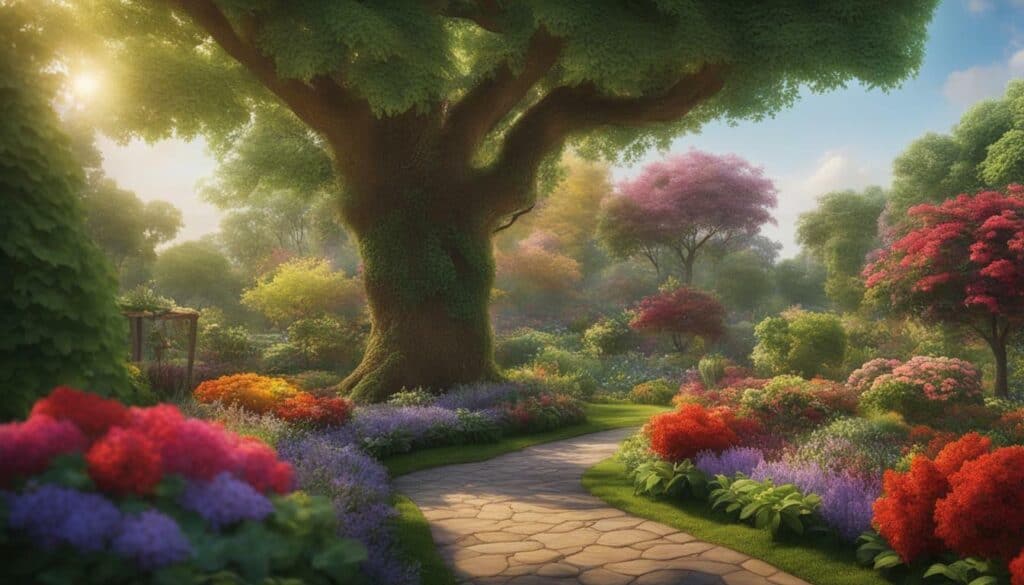
Trees offer birds somewhere to nest, feed, and shelter. In return, they will keep many plant pests in check while contributing their melodious song.
The Best Plant Food
Much of our waste can be composted. Composting is a natural process and a far more environmentally friendly alternative to burying it in landfill. Garden-made compost is often richer in valuable nutrients than bought-in sources of compost. Make your own and enjoy a free source of natural fertilizer to feed your soil and the plants growing in it. Setting up a simple compost bin or heap doesn’t take long. It’s easy to add to, and don’t worry, it won’t smell!
Reconsider Your Lawn
Lawns demand a lot of effort and watering to stay green, especially in hotter climates. How much lawn do you really need? Can any of it be repurposed? For example, a native wildflower meadow only needs mowing once or twice a year. Make the lawn that remains more sustainable by simply leaving the grass to grow a little longer between cuts. Then leave the clippings where they fall at least once a month to return their nutrients to the soil.
Reuse and Recycle
Don’t be in a haste to throw away old pots and seed containers. Reuse them as often as you can by washing them after each season so they’re ready and clean for the next. Look after your tools by storing them somewhere dry so they last longer. Keep moving parts oiled, and sharpen blades regularly so they work like new.
Opt for lower energy, natural materials in the garden – from biodegradable pots made of coir, cardboard, or even old newspaper to a greenhouse built from sustainable wood in place of aluminum. Many gardeners are only too happy to repurpose old items into new ones for the garden. And there’s all sorts of fun to be had in getting creative!
Free Resources, Naturally
Nature gives us lots for free. Set up barrels to collect rainfall and cut your consumption of treated water – and your water bill! Rake up fallen leaves to make leaf mold – the perfect material for improving soil structure or creating your own, packaging-free potting mix. Create more spaces for wildlife. Flowers rich in nectar feed pollinators, as well as drawing in other insects to feed on the bugs you don’t want. Include a pond for frogs and toads – the ultimate slug controllers!
Extra room for wildlife doesn’t mean sacrificing valuable ground space. For example, install a green roof on your shed or put together a simple bug hotel. Projects like this are great fun for adults and kids alike. Many projects are easily completed in a weekend to bring benefits lasting long into the future.
Grow What Thrives
Growing plants that naturally thrive in your location means you’ll enjoy more success and less heartache. Pick the right plant for the right place: for example, vegetables like tomatoes and beans for sunny areas or leafy salads in the shade.
Choosing the right plant for the right place in your garden puts you on the path to success. Not sure? Then use the fully searchable Garden Plans Gallery on this website to see what others are growing in your area and seek some inspiration. Or step in and explore our Garden Planner for yourself. It’s easy to narrow down the selection of plants to, for example, those that will happily grow in partial shade or are frost tolerant. And because the software knows your location, you can even filter the list to show only those plants suitable for sowing, planting or harvesting during a specific month in your location. Simple!
Don’t be in too much of a hurry at the start of the growing season. Work back from the last frost date so tender crops like squashes aren’t sown too early and are ready to plant when the time’s right. This will minimize the need for costly heating. Our Garden Planner includes a handy Plant List to help with this too!
Of course, growing any fruits, vegetables, or herbs is a big step towards a more Earth-friendly lifestyle, so grow as much as you can: plan ahead, re-sow throughout the growing season, and set aside some of your homegrown bounty for the leaner times of the year. You’ll be doing yourself and the planet a world of good.
Designing with Nature in Mind
When it comes to garden planning, it’s essential to design with nature in mind. By incorporating organic materials, enhancing soil fertility, and creating habitats for wildlife, you can create a garden that thrives naturally.
One of the key principles of designing with nature is selecting plants that are suited to your specific location. Research native plants that thrive in your area and choose species that are well-adapted to the local climate and soil conditions. This will not only ensure the success of your garden but also attract and support local wildlife.
In addition to plant selection, it’s important to use organic materials to nourish your soil and promote its fertility. Incorporate compost, leaf mold, and other natural fertilizers to enrich the soil and provide essential nutrients for plant growth. By avoiding artificial fertilizers and pesticides, you can maintain a healthier garden ecosystem and minimize harm to beneficial insects and soil life.
Pest control is another aspect of designing with nature. Instead of relying on chemical pesticides, explore natural and organic methods to manage pests in your garden. Introduce companion plants that repel pests or attract beneficial insects that prey on garden pests. This natural pest control method not only reduces the use of harmful chemicals but also creates a balanced ecosystem in your garden.
Creating wildlife habitats is an important part of designing with nature. Incorporate features such as birdhouses, bee hotels, and butterfly gardens to attract and support beneficial wildlife. Providing food, water, and shelter for birds, bees, butterflies, and other pollinators will not only enhance the biodiversity of your garden but also contribute to the overall health and resilience of your garden ecosystem.
Quote:
“A natural garden may be born from wilder roots but it’s still a garden that requires planning and thought. It can be beautiful to all species who come through the space, human and bird and spider and bee, without losing any of its power or resonance for the environment.” – Source
By designing with nature in mind, you can create a garden that not only enhances the beauty of your outdoor space but also contributes to the health of the environment. Embrace organic materials, improve soil fertility, implement natural pest control methods, and provide habitats for wildlife to unlock the full potential of your garden as a thriving ecosystem.
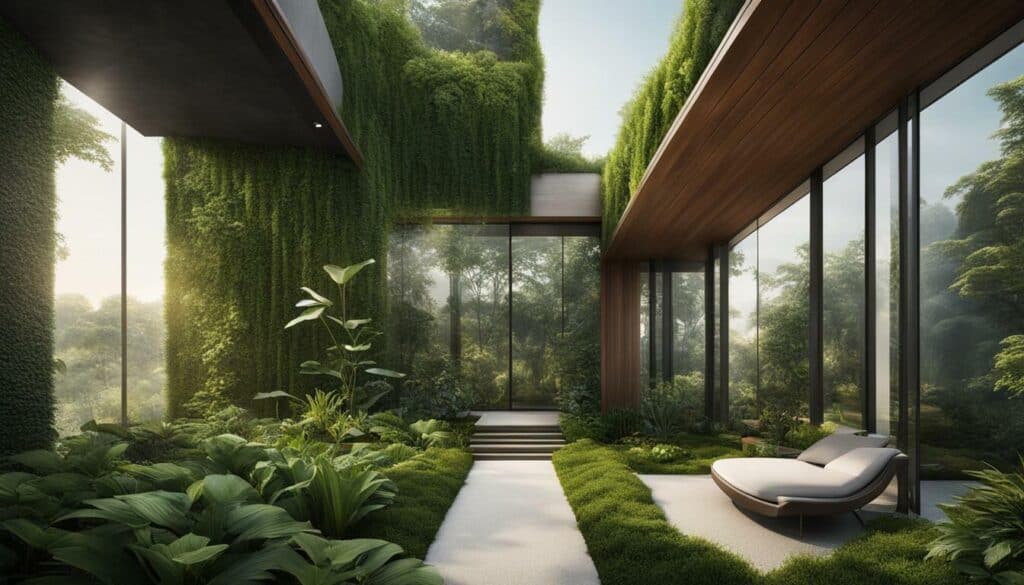
Creating a Habitat-Friendly Garden
Incorporating wildlife-friendly features into your garden is an effective way to design with nature. Consider adding bird feeders, bird baths, and nesting boxes to attract and support a variety of bird species. Planting native flowering plants, such as milkweed for monarch butterflies or native wildflowers for bees, will provide food and habitat for pollinators. You can also create a small pond or water feature to attract frogs, toads, and other beneficial amphibians.
Using Organic Mulch for Soil Enrichment
Mulching is an essential practice in designing with nature. Organic mulch not only helps conserve soil moisture and suppresses weeds but also provides valuable nutrients to the soil as it decomposes. Use materials such as wood chips, straw, or shredded leaves as mulch around your plants. This will improve soil fertility, enhance microbial activity, and create a favorable environment for earthworms and other beneficial soil organisms.
Maximizing Space with Vertical Gardening
If you have limited space in your garden, consider implementing vertical gardening techniques. Vertical structures such as trellises, arbors, or living walls can provide support for vining plants, maximize space utilization, and add visual interest to your garden. Growing plants vertically not only saves valuable ground space but also creates opportunities for more planting and biodiversity.
Designing with Nature for a Sustainable Future
Designing with nature is not only about creating a beautiful garden but also about making a positive impact on the environment. By incorporating organic materials, enhancing soil fertility, practicing natural pest control, and providing habitats for wildlife, you can contribute to a more sustainable future. Embrace the principles of designing with nature and unlock the full potential of your garden as a thriving and harmonious ecosystem.
Trees: A Powerful Asset in Garden Planning
Trees are a powerful asset in garden planning. They not only contribute to carbon sequestration but also provide shelter and food for wildlife while adding beauty and shade to your outdoor space. Planting the right trees can enhance the overall design and functionality of your garden.
When selecting trees for your garden, consider their size, growth habit, and suitability for your climate. Choose trees that will complement the existing layout and provide the desired benefits. For example, shade trees can help cool your garden and provide relief from the summer heat, while fruit trees can offer a bountiful harvest for you to enjoy.
Additionally, trees create a habitat for wildlife, attracting birds and other creatures to your garden. By planting native tree species, you can create a thriving ecosystem that supports biodiversity and promotes a healthy environment.
Carbon sequestration is another important benefit of trees in garden planning. Trees absorb carbon dioxide from the atmosphere and store it in their trunks, branches, and leaves, helping to mitigate climate change. By planting trees in your garden, you can contribute to this vital process and make a positive impact on the environment.
When designing your garden, consider the placement of trees to maximize their benefits. Choose locations that provide adequate space for growth and ensure that the trees do not obstruct views or overshadow smaller plants. Strategically placing trees can also help create defined areas within your garden, adding structure and visual interest.
To inspire you, here is an example of a garden layout that incorporates trees:

| Tree Type | Location | Benefits |
|---|---|---|
| Shade Tree | Center of the garden | Provides shade for outdoor seating area and protects smaller plants from excessive heat |
| Fruit Tree | Adjacent to the vegetable garden | Yields fresh fruits for consumption and attracts pollinators to enhance vegetable garden productivity |
| Native Tree | Perimeter of the garden | Creates a wildlife habitat, attracting birds and insects |
By incorporating trees into your garden planning, you can create a beautiful and sustainable outdoor space that benefits both you and the environment. Remember to choose trees that are suitable for your climate, provide the desired benefits, and enhance the overall design of your garden.
Composting: Enrich Your Soil and Promote Healthy Plants
Composting is an art that plays a vital role in garden planning. By recycling organic waste and creating nutrient-rich compost, you can enrich your soil and promote the health of your plants. It’s a sustainable practice that not only reduces waste but also provides a natural source of fertilizer for your garden.
Compost is created through the decomposition of organic materials such as kitchen scraps, yard waste, and fallen leaves. These materials are broken down by microorganisms and beneficial organisms like earthworms, resulting in a rich, dark humus that is full of nutrients.
To start composting, create a compost bin or heap in a suitable location in your garden. You can use a variety of materials to build your bin, including wood pallets, wire mesh, or even a repurposed trash can with holes for aeration. Add a mix of “green” materials, such as fruit and vegetable scraps, grass clippings, and coffee grounds, and “brown” materials, such as dried leaves, straw, and shredded paper. It’s important to maintain a balance between the two to ensure proper decomposition.
Regularly turning the compost pile with a garden fork or shovel helps speed up the decomposition process by providing oxygen to the microorganisms. It’s also essential to keep the compost moist but not soaking wet. If it’s too dry, add water; if it’s too wet, add dry materials like leaves or sawdust.
Composting works best when the pile is layered, with a mixture of different materials. This helps create an optimal environment for decomposition and prevents any unpleasant odors. It’s important to avoid adding meat, dairy products, or oily foods to the compost pile, as they can attract pests and slow down the decomposition process.
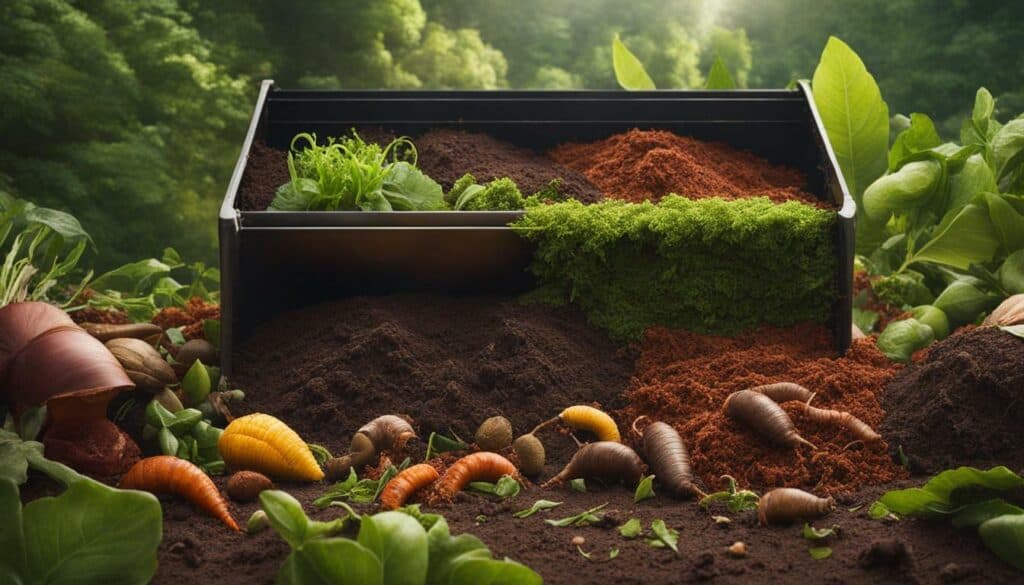
Once your compost is fully decomposed, it will resemble dark, crumbly soil and have a pleasant earthy smell. You can then incorporate it into your garden beds to improve soil fertility and provide essential nutrients to your plants. Compost helps retain moisture in the soil, promotes beneficial microbial activity, and enhances overall plant health.
By composting, you not only reduce waste but also contribute to a more sustainable garden. You’re recycling organic materials and creating a natural source of fertilizer, reducing the need for chemical fertilizers that can harm the environment. Additionally, composting helps improve soil structure and drainage, making your garden more resilient to drought and disease.
So, embrace the art of composting and unlock the benefits it brings to your garden. By recycling organic waste and creating nutrient-rich compost, you can enrich your soil, promote healthy plants, and create a more sustainable garden.
In garden planning, it’s time to rethink the traditional lawn. Consider alternatives that are not only more sustainable but also add beauty and require less maintenance.
Gone are the days when a lush green lawn was the pinnacle of backyard beauty. As we become more environmentally conscious, it’s time to rethink our approach to garden planning. Instead of devoting precious resources to maintaining a traditional lawn, consider incorporating alternatives that are not only more sustainable but also add beauty to your outdoor space. Here are some lawn alternatives to consider:
| Lawn Alternatives | Description |
|---|---|
| Native Wildflowers | Replace your lawn with a native wildflower meadow. Native wildflowers require less water and maintenance, and they provide important habitat for pollinators like bees and butterflies. |
| Ground Covers | Choose low-growing ground covers like creeping thyme or moss to create a beautiful carpet-like effect. These alternatives require less mowing and watering compared to traditional lawns. |
| Xeriscaping | Consider xeriscaping, which involves using drought-tolerant plants and gravel or mulch to create a low-maintenance and water-efficient landscape. This is especially suitable for regions with limited water resources. |
By embracing lawn alternatives, you not only reduce water consumption and save time on maintenance but also create a more diverse and eco-friendly landscape. Native wildflowers attract beneficial insects and provide food sources for wildlife, while ground covers help prevent soil erosion. Xeriscaping, on the other hand, conserves water and reduces the need for irrigation.
“A natural garden or landscape is an increasingly popular solution for all of these situations, but perhaps you’re worried it will look too weedy or messy.”
It’s important to note that lawn alternatives can be just as visually appealing as a traditional lawn. In fact, they often add a unique charm and natural beauty to your garden. Native wildflowers create a vibrant and ever-changing display of colors, while ground covers form interesting textures and patterns. Xeriscaped landscapes can be designed with artistic arrangements of rocks, succulents, and other drought-resistant plants.
Furthermore, lawn alternatives require less maintenance, allowing you to spend more time enjoying your outdoor space rather than laboring over it. With reduced mowing and watering, you’ll have more free time to relax or engage in other garden activities.
Water Conservation
One of the key benefits of exploring lawn alternatives is water conservation. Traditional lawns often require extensive watering, especially in drier regions, leading to excessive water usage. By choosing alternatives that are adapted to your local climate, you can significantly reduce water consumption in your garden.
- Consider installing a rainwater harvesting system to collect and store rainwater for irrigation purposes.
- Choose plants that are drought-tolerant and can thrive with minimal water.
- Group plants with similar water needs together to maximize efficiency.
By implementing these water conservation strategies and embracing lawn alternatives, you can make a positive impact on the environment and reduce your water bill at the same time.
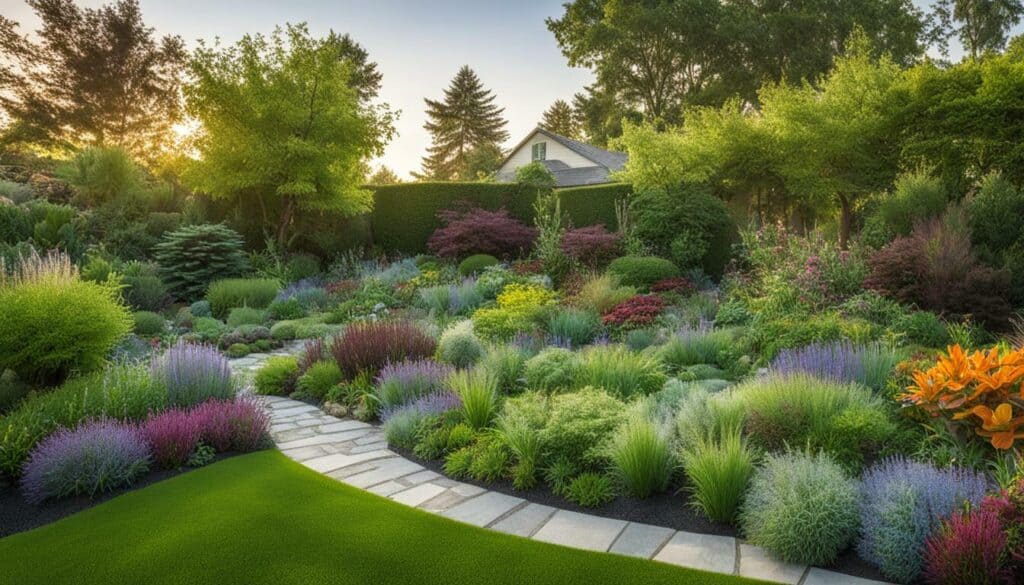
Less Maintenance, More Enjoyment
One of the advantages of lawn alternatives is their low maintenance requirements. Traditional lawns often demand frequent mowing, fertilizing, and weeding to keep them looking pristine. In contrast, lawn alternatives require minimal upkeep, allowing you to spend more time enjoying your garden and less time on laborious tasks.
“A natural garden may be born from wilder roots but it’s still a garden that requires planning and thought.”
With lawn alternatives, you can say goodbye to the noise and emissions of lawnmowers, as well as the hassle of maintaining perfectly manicured grass. Instead, you can focus on creating a sustainable and beautiful landscape that supports biodiversity and enhances the overall aesthetics of your outdoor space.
In garden planning, it’s time to rethink the traditional lawn and explore alternatives that are more sustainable, visually appealing, and require less maintenance. By embracing lawn alternatives, such as native wildflowers, ground covers, and xeriscaping, you can conserve water, support biodiversity, and create a unique and eco-friendly garden. So let’s break free from the conventional lawn and unlock the beauty of nature in our outdoor spaces.
Garden planning goes hand in hand with reducing waste, reusing materials, and recycling.
Garden planning is not just about creating a beautiful outdoor space; it’s also about being mindful of the environment and making sustainable choices. By incorporating these practices into your garden design, you can minimize waste, repurpose materials, and contribute to a healthier planet.
Reduce
One of the key principles of sustainable gardening is reducing waste. Instead of throwing away old pots and seed containers, consider reusing them. Clean them after each season, so they’re ready for the next planting. By reusing these materials, you can minimize the amount of waste ending up in landfills.
Another way to reduce waste is by choosing sustainable materials for your garden. Opt for biodegradable pots made of coir, cardboard, or old newspaper instead of plastic containers. Not only are these materials better for the environment, but they also break down naturally over time, reducing waste.
Reuse
Repurposing materials is another great way to create a sustainable garden. Instead of buying new gardening tools, consider repurposing old ones. Store them in a dry place to extend their lifespan, and regularly oil moving parts and sharpen blades to keep them in top shape. By reusing these tools, you can minimize the need for new, resource-intensive products.
“Many gardeners are only too happy to repurpose old items into new ones for the garden. And there’s all sorts of fun to be had in getting creative!”
Additionally, consider repurposing other items in your garden. Old furniture, pallets, or crates can be transformed into unique planters or garden accents. Get creative and give new life to old items while reducing waste.
Recycle
Recycling is an essential practice in sustainable gardening. Instead of throwing away organic waste, such as kitchen scraps and yard trimmings, compost them. Composting is a natural process that creates nutrient-rich fertilizer for your garden. Setting up a compost bin or heap is easy and can significantly reduce the amount of waste you produce.
When it comes to choosing materials for your garden, opt for recycled or sustainable options. Look for products made from recycled materials, such as reclaimed wood or recycled plastic. By using these materials, you can contribute to the recycling loop and reduce the demand for new resources.
Embrace Sustainable Materials and Gardening Tools
Choosing sustainable materials and gardening tools is crucial for a truly eco-friendly garden. Look for products that are made from renewable resources or have minimal environmental impact. This includes biodegradable pots, sustainable wood for structures like greenhouses, and eco-friendly fertilizers and pesticides.
When selecting gardening tools, opt for durable, high-quality options that will last for many seasons. Look for tools made from recycled materials or those that have minimal packaging. By choosing sustainable gardening tools, you can reduce waste and ensure that your tools are built to last.
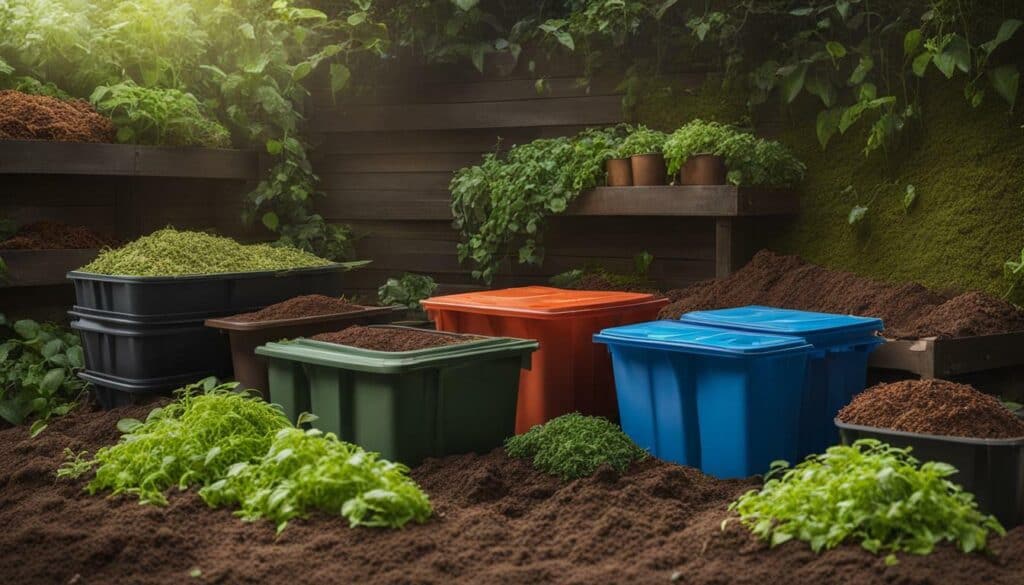
By incorporating these practices into your garden planning, you can create a more sustainable and eco-friendly outdoor space. Reducing waste, reusing materials, recycling, and choosing sustainable options for your garden will not only benefit the environment but also contribute to the overall beauty and health of your garden.
Embrace Nature’s Resources
Nature provides us with abundant resources that can be harnessed in garden planning. From collecting rainwater to creating leaf mold and incorporating wildlife-friendly features, you can maximize the benefits of nature in your garden.
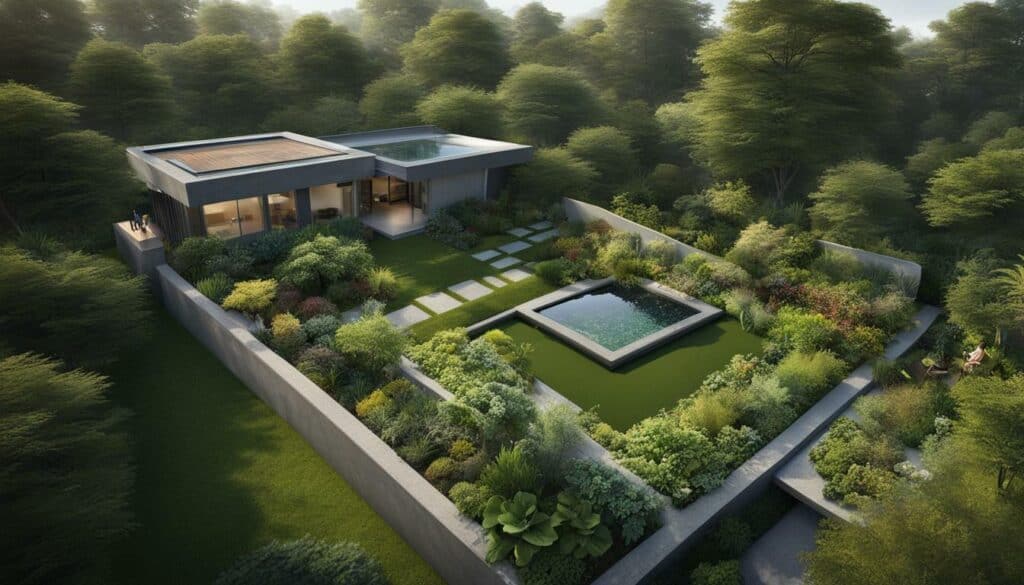
One of the most valuable resources provided by nature is rainwater. Instead of relying solely on treated water for your garden, consider setting up rain barrels to collect rainfall. This not only reduces your water consumption but also helps to lower your water bill. Plus, rainwater is naturally filtered and free from chemicals, making it ideal for watering your plants.
Rainwater Harvesting: Tips and Tricks
- Position your rain barrel under a downspout to catch the most water.
- Ensure your rain barrel has a tight-fitting lid to prevent debris and mosquitoes from entering.
- Use a watering can or attach a hose to your rain barrel for easy access to the collected water.
- Consider adding a drip irrigation system to efficiently distribute the harvested rainwater to your plants.
- Regularly clean your rain barrel to prevent bacteria growth and ensure the quality of the collected water.
In addition to rainwater harvesting, another way to utilize nature’s resources is by creating leaf mold. Fallen leaves can be collected and placed in a compost bin or heap to decompose over time. This process creates a nutrient-rich material that can be used as a natural soil amendment and mulch. Leaf mold improves soil structure, retains moisture, and provides a steady release of nutrients to your plants.
Leaf Mold Creation: Steps to Follow
- Rake up fallen leaves from your garden or collect them from your neighborhood.
- Shred the leaves into smaller pieces to speed up the decomposition process.
- Place the shredded leaves in a compost bin or create a leaf pile in a designated area of your garden.
- Keep the leaves moist by watering them occasionally to facilitate decomposition.
- Wait for the leaves to break down and turn into dark, crumbly leaf mold. This usually takes about 6-12 months.
- Spread the finished leaf mold around your plants to improve soil fertility and retain moisture.
“Rainwater harvesting and leaf mold creation are just two examples of how we can tap into nature’s resources to benefit our gardens. By utilizing these methods, you not only reduce your reliance on treated water and synthetic fertilizers but also contribute to a more sustainable and eco-friendly garden.”
To create a more wildlife-friendly garden, consider incorporating features that provide habitat and support biodiversity. Green roofs, for example, are becoming increasingly popular as they offer multiple benefits. They provide insulation, mitigate stormwater runoff, and create additional growing space for plants. Green roofs also attract birds, butterflies, and other pollinators, enhancing the ecological value of your garden.
Creating a Wildlife-Friendly Garden: Tips and Ideas
- Plant native plants that provide food and shelter for local wildlife.
- Include flowering plants that attract pollinators like bees and butterflies.
- Install birdhouses, bat boxes, or bee hotels to provide nesting sites.
- Add a small pond or water feature to attract frogs, insects, and birds.
- Leave some areas of your garden wild and untamed to provide cover for wildlife.
“By embracing nature’s resources in our garden planning, we not only create beautiful and sustainable spaces but also have a positive impact on the environment. Rainwater harvesting, leaf mold creation, and wildlife-friendly features are just a few examples of how we can work with nature to enhance our gardens and support biodiversity.
By harnessing the power of rainwater, creating leaf mold, and incorporating wildlife-friendly features, you can truly unlock the potential of nature in your garden. Embracing these resources not only benefits your plants and the environment but also creates a harmonious and thriving outdoor space.
In Conclusion: Unlocking Nature’s Beauty
In conclusion, by implementing these garden planning tips and embracing sustainable practices, you can unlock the true beauty of nature in your garden while promoting a healthier planet. A garden designed with nature in mind not only enhances the visual appeal of your outdoor space but also creates a habitat for beneficial wildlife, improves soil fertility, and reduces environmental impact.
Embrace Nature-Inspired Gardening
A nature-inspired garden is a harmonious blend of beauty and sustainability. By working with nature rather than against it, you can create a garden that thrives without harmful chemicals and excessive maintenance. Choose native plants that are well-suited to your location and consider their natural habitat requirements to ensure optimal growth.
Implement Sustainable Practices
Sustainability should be at the core of garden planning. Replace electric or gasoline-powered equipment with human-powered alternatives to reduce resource consumption and stay active. Opt for organic materials to improve soil fertility and attract beneficial insects that naturally control pests. Plant more trees to sequester carbon dioxide, provide habitat for wildlife, and enjoy their beauty and fruit production.
Create a Wildlife Habitat
Aim to create a diverse ecosystem in your garden that supports a wide range of wildlife. Incorporate features like ponds, wildflower patches, and green roofs to provide food, water, and shelter for birds, butterflies, and other creatures. By designing with nature in mind, you can help restore the balance of ecosystems and promote biodiversity.
Utilize Natural Resources Wisely
Make the most of nature’s resources to foster a sustainable garden. Collect rainwater in barrels to reduce water consumption and use it to irrigate your plants. Create compost from organic waste to enrich the soil and provide natural fertilizer. Embrace alternative lawn options like native wildflower meadows that require less water and maintenance.
Reduce Waste and Repurpose
Minimize waste in your garden planning by repurposing materials and recycling whenever possible. Reuse old pots and seed containers, and store tools properly to prolong their lifespan. Choose biodegradable and sustainable materials for your gardening needs. Get creative and repurpose old items into new ones for your garden, adding a unique touch to your outdoor space.
By following these garden planning tips and embracing sustainable practices, you can create a beautiful and flourishing garden that is in harmony with nature. Let your garden be a testament to the power of nature-inspired gardening and the positive impact it can have on both your personal space and the environment.
FAQ
Q: What are some sustainable gardening practices I can adopt?
A: Some sustainable gardening practices include using organic materials, avoiding artificial fertilizers and pesticides, and planting trees to mitigate climate change.
Q: How can I create a wildlife-friendly garden?
A: To create a wildlife-friendly garden, you can plant flowers that attract pollinators, include a pond for frogs and toads, and provide shelter and food sources for birds.
Q: What are the benefits of composting?
A: Composting is a natural process that enriches the soil and reduces waste. It provides a free source of natural fertilizer for your garden and helps to build long-term soil fertility.
Q: How can I reduce the environmental impact of my lawn?
A: Instead of traditional lawns, consider alternatives like native wildflower meadows that require less water and maintenance. You can also leave grass clippings on the lawn to return nutrients to the soil.
Q: How can I repurpose materials in my garden?
A: You can repurpose old pots and seed containers, use biodegradable materials like coir or cardboard for pots, and repurpose old items into new ones for the garden. Get creative and have fun!
Q: How can I make use of nature’s resources in my garden?
A: You can collect rainwater in barrels to reduce your consumption of treated water, make leaf mold from fallen leaves to improve soil structure, and incorporate wildlife-friendly features like green roofs.
Q: Why is it important to choose plants that are suited to my location?
A: Choosing plants that naturally thrive in your location increases your chances of success and reduces the need for excessive maintenance. It’s important to pick the right plant for the right place in your garden.
Q: How can I create a beautiful garden that supports the environment?
A: By implementing sustainable gardening practices, designing with nature in mind, and utilizing natural resources, you can create a beautiful garden that is in harmony with the environment and supports wildlife.
Can the Flower Planting Tips for Beginners be Applied to Garden Planning as Well?
Garden planning can definitely benefit from flower planting basics for beginners. By understanding the fundamentals of selecting and spacing plants, as well as considering sunlight requirements and soil conditions, beginners can create a well-designed garden. Applying these tips ensures a visually pleasing and healthy garden, where flowers thrive in their optimal environment.

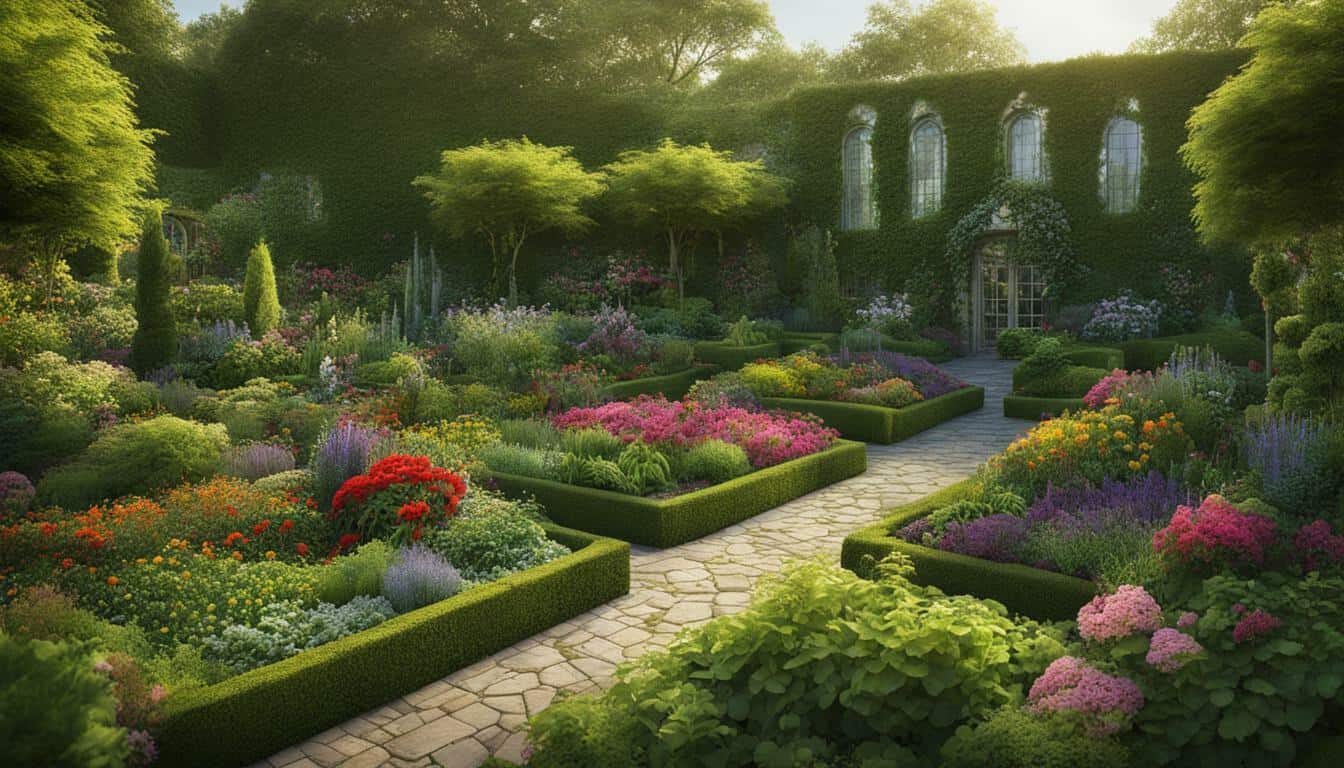



Leave a Reply